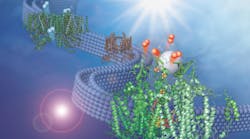Scientists at Argonne National Laboratory have adapted a chemical reaction pathway central to plant biology to form the backbone of a new process that converts water into hydrogen fuel using energy from the sun.
The research teams have combined two membrane-bound proteins to perform a complete conversion of water molecules to hydrogen and oxygen. The work builds on an earlier examination of one of the proteins, called photosystem I, a membrane protein that uses energy from light to feed electrons to an inorganic catalyst that makes hydrogen. This part of the reaction, however, represents only half of the overall process needed for hydrogen generation.
A second protein called Photosystem II uses energy from light to split water and take electrons from it. This protein lets the researchers take electrons from water and feed them to photosystem I.
The team embedded the two proteins in thylakoid membranes, like those found inside the oxygen-creating chloroplasts in higher plants. The membrane structurally supports both proteins and provides a direct pathway for inter-protein electron transfer, but doesn’t impede catalyst binding to photosystem I.
The Z-scheme—the technical name for the light-triggered electron transport chain of natural photosynthesis that occurs in the thylakoid membrane—works well with the synthetic catalyst.
Researchers were also able to substitute cobalt or nickel-containing catalysts for the expensive platinum catalyst that had been used in earlier studies. The new cobalt or nickel catalysts could dramatically reduce potential costs.
The next step for the research involves incorporating the membrane-bound Z-scheme into a living system. If they succeed in getting the process to work inside a living organism, hydrogen prosecution should dramatically increase.

